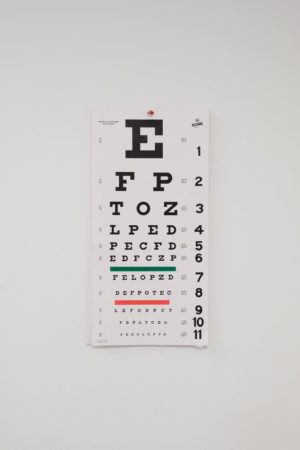We have all either heard someone or ourselves brag that we have “20/20 vision”. But what does that exactly mean? And is it an accurate indicator of “perfect” vision?
That 20/20 number is a term used to represent normal or ‘perfect’ vision. This number measures visual acuity, which is the clarity or sharpness of your vision measured at a distance of 20ft. So if you have 20/20 vision, you can see at 20ft what someone with perfect vision can see at that distance. If someone has less than average vison, say 20/70, what they see at 20ft is what a person with perfect vision can see at 70ft. While visual acuity is a good measure of the sharpness and clarity of your vision, it does not take into consideration other fundamental aspects of vision. Visual acuity is also not the determining factor in your overall eye health.
If you’ve seen an eye doctor, your visual acuity was tested using the “big letter poster” or Snellen chart. A Dutch ophthalmologist developed the chart in the 1800s. The sizes of the letters are precisely calculated to adhere to the standard of the 20/20 scale. The letters are also carefully chosen. You may have noticed that the only letters used are C, D, E, F, L, N, O, P, T, and Z. The reason behind these letter choices is that some letters can be distinguished even with blurry vision. For example, the letter Q’s tail can be recognized because there are no other letters like it. While the standard for this chart is 20/20 A.K.A “perfect” vision, some people can see better than 20/20 and are born with 20/15 or even 20/12 vision. These people have what is called “supernormal vision.” People who had LASIK surgery can usually see 20/20 or better, and people can be prescribed glasses or contact lenses that can help them see 20/20 (or better).

The Snellen chart is an excellent indicator for your eye doctor to determine if you need glasses or contacts. However, this is not the only test you should be given during a comprehensive eye exam. While vision and focus are critical, overall eye health is also essential. Good focus and good eye health do not always go hand in hand. Vision traits that contribute to your overall visual ability include your peripheral vision or side vision, eye coordination, depth perception, focusing ability, and color appreciation. Even if you have excellent vision, you should go for an eye exam once every year or two years. Eye doctors are also looking for your risk of eye diseases such as cataracts or glaucoma. If you have any pre-existing medical conditions, this could also impact your vision as well. Besides, focus is not static through a lifetime, and changes are bound to happen to everyone.
So the next time you hear friends or family say they have 20/20 vision and don’t need their eyes checked, be sure to inform them there is a lot more to vision than they think.



